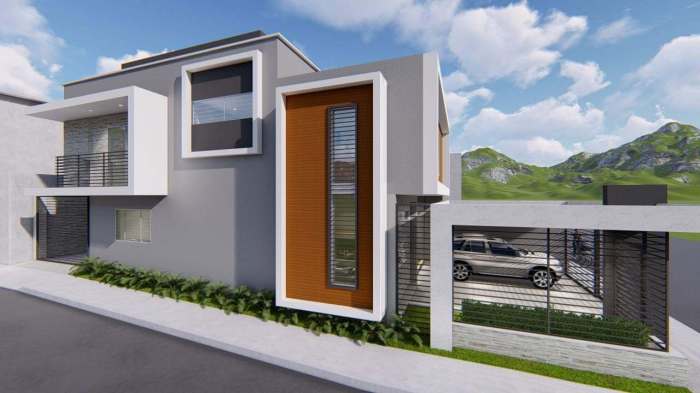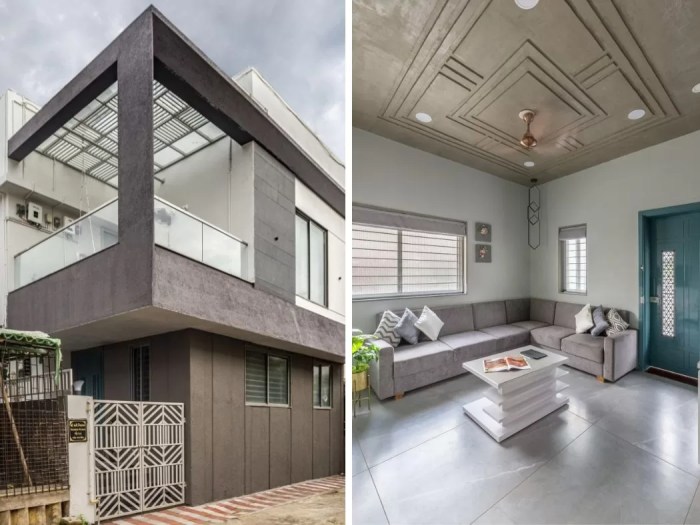Exploring Minimalist House Design: A Guide to Simple and Functional Living
Delving into minimalist house design, this introduction immerses readers in a unique and compelling narrative, providing a detailed look at the principles, elements, and practices that define this architectural style. From interior elements to sustainable practices, this guide covers everything you need to know about creating a minimalist home that combines simplicity with functionality.
Overview of Minimalist House Design

Minimalist house design focuses on simplicity, clean lines, and a clutter-free environment. The key principles of minimalist design include using a limited color palette, prioritizing functionality over decoration, and emphasizing open spaces.
Significance of Simplicity and Functionality
In minimalist architecture, simplicity is crucial as it helps create a sense of calm and serenity in the living space. By reducing unnecessary elements and decorations, the focus is on essential features that serve a purpose. Functionality plays a vital role in minimalist house design, ensuring that each element serves a practical function while maintaining a sleek and uncluttered aesthetic.
Common Characteristics of Minimalist House Designs
- Clean lines and geometric shapes
- Neutral color palette with pops of bold colors
- Open floor plans with minimal partitions
- Use of natural materials like wood, stone, and metal
- Emphasis on natural light and ventilation
- Minimal furniture and decor items
Interior Elements in Minimalist House Design
Minimalist house design focuses on simplicity, functionality, and clean lines. The interior elements play a crucial role in achieving this aesthetic while creating a sense of calm and spaciousness within the home.
Essential Interior Elements
Minimalist homes typically feature furniture with sleek and simple designs, such as low-profile sofas, streamlined tables, and minimalistic storage solutions. The color palette is often neutral, with white, beige, gray, and black being prevalent choices. Lighting is essential in minimalist design to enhance the sense of openness and highlight the clean lines of the space.
Choice of Materials
Minimalism influences the choice of materials in interior design by prioritizing quality over quantity. Common materials used in minimalist homes include natural wood, glass, metal, and concrete. These materials are often left in their natural state or with minimal finishing to maintain a sense of simplicity and authenticity.
Examples of Minimalist Interior Design
Minimalist interior design often prioritizes clean lines, open spaces, and a focus on functionality. For example, a living room may feature a simple sofa with geometric shapes, a coffee table with clean lines, and a few carefully curated decorative elements.
The use of negative space is also common in minimalist design to create a sense of balance and harmony within the space.
Exterior Features of Minimalist House Design

Minimalist house design is characterized by simplicity, clean lines, and a focus on functionality. When it comes to the exterior features of a minimalist house, there are several key elements that define this style.
Geometric Shapes and Neutral Colors
In minimalist architecture, geometric shapes play a crucial role in defining the exterior of the house. Sharp angles, straight lines, and simple forms are commonly used to create a sleek and modern look. Additionally, neutral colors such as white, black, gray, and beige are often chosen to maintain a clean and understated appearance.
Landscaping for Minimalist Exterior Design
Landscaping can play a significant role in complementing the minimalist exterior design of a house. Simple and well-maintained landscaping with clean lines and minimal ornamentation can enhance the overall aesthetic of the property. Strategic placement of plants, rocks, and other natural elements can create a harmonious balance with the architectural features of the house.
Natural Light and Ventilation in Minimalist Architecture
Natural light and ventilation are essential aspects of minimalist architecture. Large windows, glass doors, and skylights are often incorporated into the design to maximize natural light and create a sense of openness. Proper ventilation is achieved through strategically placed openings and the use of materials that allow for airflow, contributing to a comfortable and airy living environment.
Sustainable Practices in Minimalist House Design
When it comes to minimalist house design, sustainability plays a crucial role in creating homes that are not only aesthetically pleasing but also environmentally friendly. By integrating sustainable materials and energy-efficient solutions, minimalist homes can minimize their impact on the environment while maximizing efficiency and functionality.
Integration of Sustainable Materials
Minimalist house design often incorporates sustainable materials such as reclaimed wood, bamboo, recycled glass, and concrete. These materials not only reduce the carbon footprint of the construction process but also promote the efficient use of resources. By choosing eco-friendly materials, minimalist homes contribute to a healthier environment and a more sustainable future.
Energy-Efficient Solutions
Minimalist homes are known for their emphasis on natural light and ventilation, which reduces the need for artificial lighting and air conditioning. Additionally, energy-efficient appliances, solar panels, and proper insulation help minimize energy consumption and lower utility costs. By implementing these solutions, minimalist house design aligns with eco-friendly practices and promotes energy conservation.
Minimal Environmental Impact
The concept of minimal environmental impact in minimalist house design goes beyond just using sustainable materials and energy-efficient solutions. It also involves thoughtful planning, efficient use of space, and a focus on durability and longevity. By designing homes that are built to last and require minimal maintenance, minimalist house design reduces waste and contributes to a more sustainable lifestyle.
Concluding Remarks
In conclusion, minimalist house design offers a harmonious blend of aesthetics and purpose, reflecting a lifestyle focused on essentialism and sustainability. With its clean lines, open spaces, and eco-friendly approach, minimalist architecture continues to inspire modern living spaces that prioritize quality over quantity.
Embrace the beauty of minimalism and transform your home into a sanctuary of simplicity and style.
Key Questions Answered
What are the key principles of minimalist design?
Minimalist design focuses on simplicity, functionality, and the elimination of unnecessary elements to create clean and uncluttered spaces.
How does minimalism influence the choice of materials in interior design?
Minimalism often favors natural materials such as wood, stone, and metal, emphasizing their quality and texture over ornate details.
What exterior features define a minimalist house?
Geometric shapes, neutral colors, and simple lines are common exterior features that characterize minimalist house design.
How can landscaping complement a minimalist exterior design?
Landscaping in minimalist design focuses on creating a harmonious relationship between the natural surroundings and the architectural simplicity of the house.
How do minimalist design principles align with eco-friendly practices?
Minimalist design often prioritizes sustainability by using energy-efficient solutions, eco-friendly materials, and minimizing environmental impact.